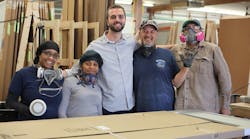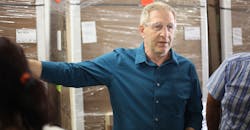At Zenbooth headquarters in Berkeley, Calif., the train thunders through every 15 minutes or so. Helpfully for the collective office sanity, the company makes “office phone booths” that muffle outside sounds. Seven of the quiet rooms are spread throughout its office and manufacturing spaces. So if the train roars by or a neighbor’s CNC machining threatens to derail an important conversation, workers can hop in one of the booths.
Zenbooth, whose biggest customers are Silicon Valley tech companies, did $5 million in revenue last year, but it almost didn’t make it past the startup phase. Its entrepreneurial founders were trying to produce a product at the same time they were learning manufacturing by trial and a lot of error.
“I sold a prototype that was just a sketch without knowing how to make it,” recalls CEO Sam Johnson, 31, whose previous experience was in tech startups in Australia. With the help of some collaborators and a woodworking class, he built the first prototype booth in a Silicon Valley tech shop in 2016 and it sold for $1,000.* Twenty advance orders quickly followed. (“We grew the business from customers paying in advance; there’s no outside money,” says Johnson.)
The next 20 or 30 booths, which have skylights and are swaddled in a layer of recycled denim for sound absorption, were cut and hammered by hand in a cabinet shop. “You cut a whole bunch of panels, and then if you’re off by an eighth of an inch …” Johnson starts laughing. “It’s super frustrating. And you have to hang a door on it, too, so there’s a really low margin for error.”
The company eventually found its own production/office space in manufacturing-scare Berkeley, but still lacked manufacturing expertise. “There was a long while there when it was very challenging, and I thought to myself, ‘Why am I doing everything the hard way?’” muses Johnson. “Because a lot of competitors entered the market and just contracted the manufacturing and focused on design and marketing.”
But Johnson believed doing the manufacturing would give him an advantage in order fulfillment and speed to market. “If you’re creating products for the first time in a category, which we intend to continue doing, it’s easier to do that in-house,” he says. “We’re now on to, like, Version 17 of our original product because we’re doing all the manufacturing ourselves.”
Tesla Travails
Manufacturing rescue came from a Boeing veteran named Gary Weber. In 2017, having left Seattle for the Bay Area, he was working as a lean manufacturing coach at Tesla and having some frustrations at the lean-agnostic carmaker. “A lot of the automation was not really working,” he recalls.
At one point, Weber was assigned to the “tent city” assembly line set up in the parking lot at the Tesla plant in Fremont, Calif., to fix processes that had gone rogue. “They kind of threw me out there,” he recalls of the assignment. “It was deathly cold.” Wheel alignments had ballooned to 15 minutes from an ideal time of 2 minutes 14 seconds and involved, much to Weber’s mystification, putting 160 pounds of sandbags on the front passenger seat. “They told us, ‘The engineers are saying we need the weight on the wheels to make this alignment.’”
“I said, ‘Seriously? Is there no other way to do that?’’ Two weeks later, the sandbags went away. Eventually, the team got the alignments down to 1 minute 13 seconds. Weber showed the workers a teaching video of a racing pit crew in action, to help them realize “that each of them is a team member and they have their position to play; don’t’ get into anyone else’s work,” he says. “And then they started to position things closer to the car and ready for the last second movement. So they really had to learn how to react when the car rolled into the pitch.”
But long hours and, at the time, Tesla leadership’s belief in fixing problems with automation before perfecting processes made Weber open to a new consulting opportunity when a headhunter called.
The real selling point was that Zenbooth was located right on the route between Tesla’s two plants, so on his travels back and forth, Weber could “stop by two, three hours a week and coach them.” He didn’t know what their backlog was, “but I saw in their faces and I sensed a bit of panic—I actually felt that, and I haven’t seen that before. Some companies don’t know that they should panic. But I saw it with these guys.
“They were in a pretty bad spot at that point. They had four operators, and each operator was crafting their own booth, so they were producing four a day, but they had no assembly method. All four of them did it a little bit different.”
But they were eager to hear his advice, and he liked that they were positive and willing to learn even in desperation. When he gave them homework assignments—like, figure out how long each panel takes to make, or fill in the missing information on a value-stream map—at first they didn’t do it, but quickly realized the assignments were important and fell in line. “They were hungry to find a better way,” says Weber.
Weber took a look at the process with the Zenbooth crew. Together, they put together an assembly line to break up the tasks into logical stations, and reworked the layout of the factory to accommodate work stations customized for each task, one panel at a time—sanding, attaching insulation, wiring, wrapping the panels with protective edges, preparing for shipment, etc. (the booths are assembled after delivery). They added two operators to the crew to keep the tasks synchronized. With Weber’s help, they created pitch management boards to track work and speed.
The team went from producing four booths a day to seven—roughly, one per hour. “We’re in an effort to prove that we can do 10 [a day],” says Weber, who is now directing the company’s manufacturing full-time. A thirty-day lead time has shrunk to “we could ship it out on Amazon tomorrow.”
“We’ve analyzed our data during our busiest six months, and we determined a finished inventory we needed for each model of booths,” says Weber. “Once we established that, we turned our push process into a pull system.” A new version of the booth requires less cutting, and plans call for adding a split shift for CNC machining as sales increase.
Along with the gradual process improvements, Weber (who started out in HR at Boeing) also brought in exercises around values and culture that have been invaluable, says Johnson, and his leadership has changed the psyche of the team. “There’s just this huge psychological element to having someone who is more experienced who you can share the successes and failures with as a team,” Johnson says. “Mistakes still happen, but he’s got the competency to rapidly handle it, as opposed to a bit of hand-waving with people who are less experienced.”
Most of the crew is under 35, while Weber is nearing retirement. The mentoring goes both ways. “These guys have really adapted to collaborative software and applications that help them talk to each other,” Weber says. “They resolve things really fast and have whole conversations almost in a blink of an eye. Once I saw the benefits, I had to push myself to get onboard.”
The collaboration extends to snacks, where Zenbooth’s head of HR recently laid out an array of possibilities on a work table and asked for Weber’s input on whether he preferred munchies or snacks that were more of a meal.
“I’m nearing the end of my career, and this has been the most enjoyable place I’ve ever worked,” Weber enthuses. I have to say, it’s because there’s a comradeship with this crew, and it’s a remarkable thing. It’s wonderful to come to work. We have fun, we have differences and sometimes we have harsh words, but we have always come back together.”
*The original story misstated the selling price of the prototype as $100,000.






